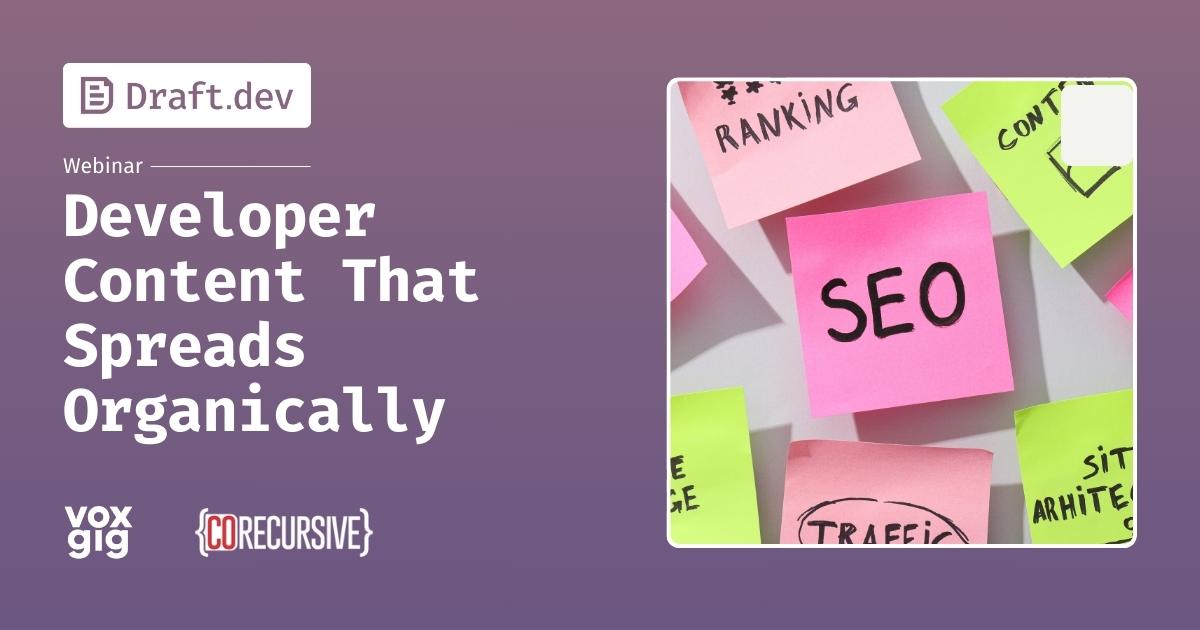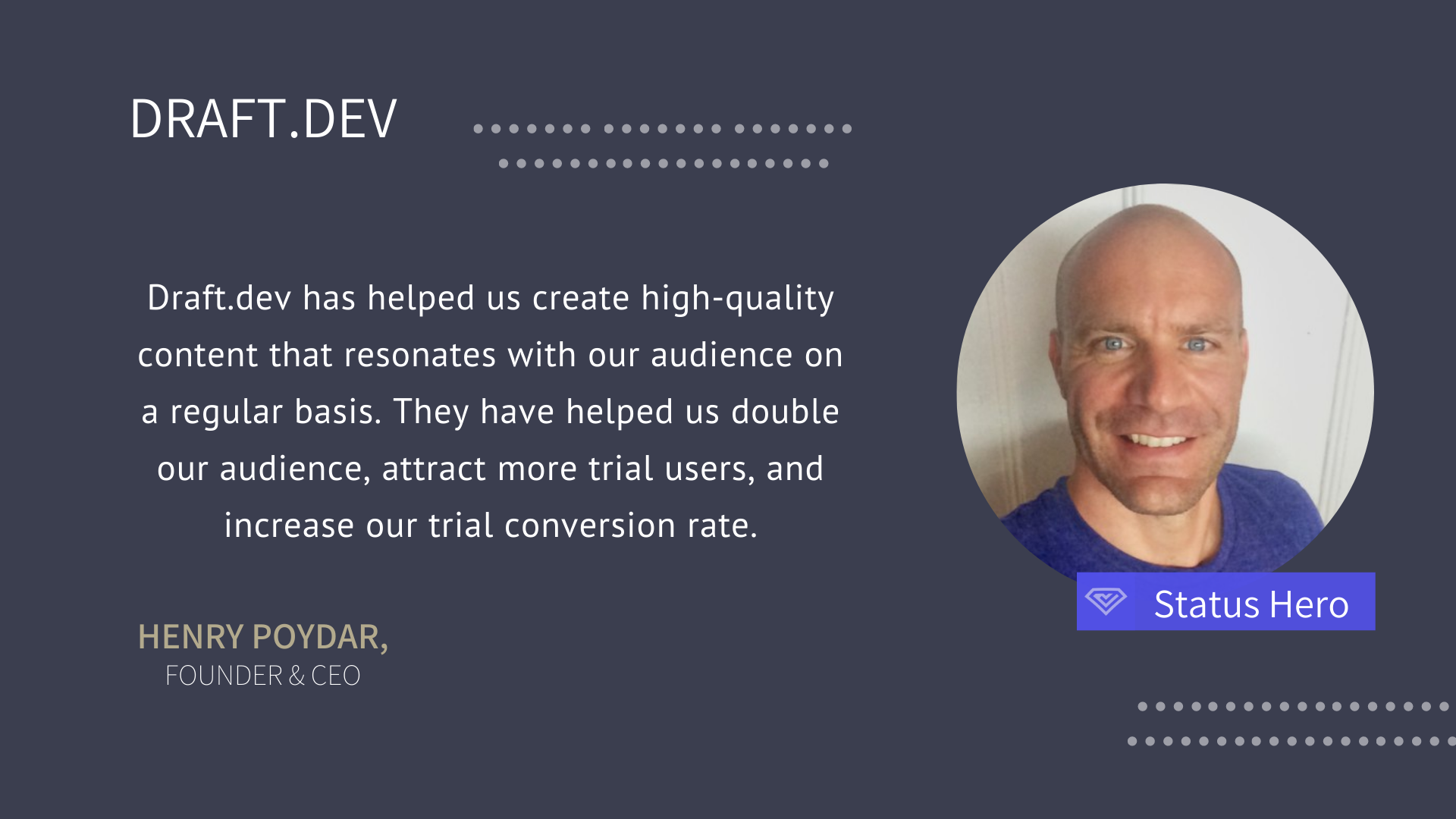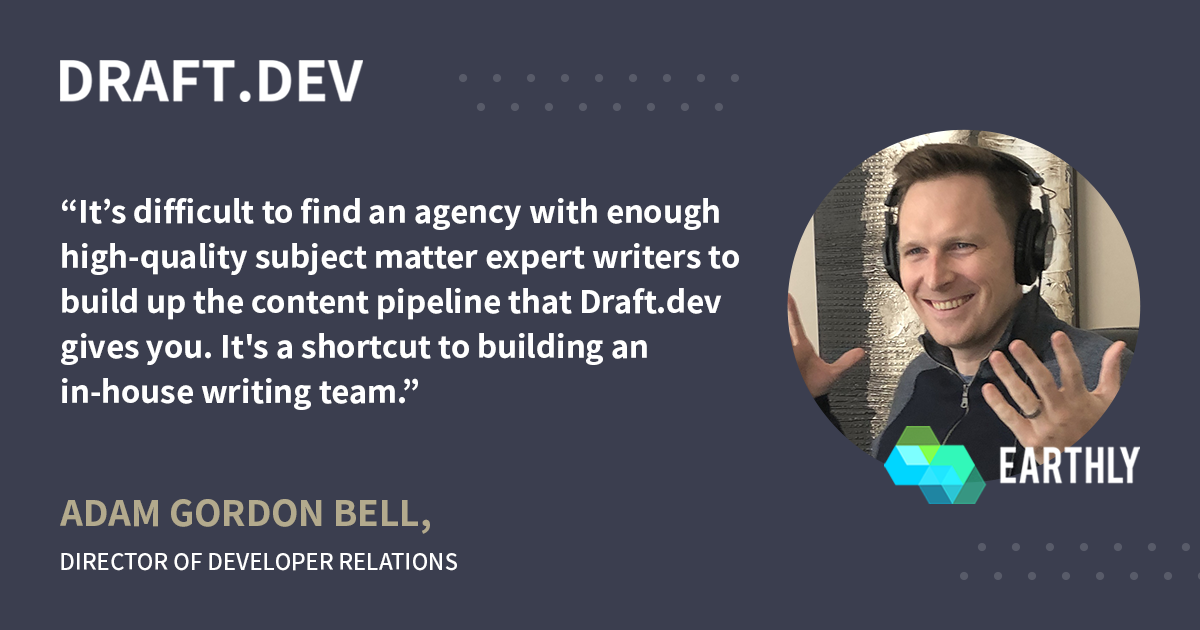Category: content-marketing
-

Creating Developer Content That Spreads Organically
In this Draft.dev webinar, we explore how to create technical marketing content that resonates with developer audiences and spreads organically.
-

Content Marketing Resources
Here we’ve collected Draft.dev’s favorite resources for content marketing teams. Whether you’re looking to learn about content marketing, recruiting writers, or writing technical blog posts, you’ve come to the right place. Two Content Marketing Strategies for Early-Stage Startup SEO We’ve worked with over 100 startups over the past three years at Draft.dev, so I’ve…read more.…
-

Two Content Marketing Strategies for Early-Stage Startup SEO
We’ve worked with over 100 startups over the past three years at Draft.dev, so I’ve heard just about every question about SEO (search engine optimization) you can imagine. Two of the most common questions that founders and early marketing hires ask me are: These are complex questions, but after digging into them many times, here’s…
-

The Startup Marketing Checklist
I tried dozens of side projects before starting Draft.dev, and now I’ve worked with hundreds of early-stage startups to help with marketing. So, a lot of founders ask me how to get started in marketing when your marketing budget is small and your product is new. I created this list to give people an answer…
-

Scaling Developer Content
Because you’re reading this, I’m going to assume that you already know content is a great way to reach software developers. When done well, content helps you build trust, reach new customers, mitigate support requests, and augment your sales process. But once you see content working, the next question is how much content do you…
-

Developer Content: The Cornerstone of Product-Led Growth
Product-led growth (PLG) has been one of the hottest terms in marketing for several years, and recently it’s become more prominent in the developer marketing space. Coined in 2016 by Blake Bartlett at OpenView Partners, product-led growth describes a growth model where product usage drives customer acquisition, retention, and expansion. Twilio, Stripe, and Shopify are…
-

Finding and Hiring Developer Relations Professionals
To say that Developer Relations is booming is an understatement. Half of all DevRel programs were instituted less than two years ago. A quarter of companies doing DevRel have multiple programs active and 33.5% of these companies aren’t even what we think of as traditional “technology” companies. It seems that any business with a connection…
-

Maximizing Your Content Marketing ROI
The content you create should align with where your prospects are in the funnel. Discover how to maximize your marketing ROI.
-

Content Marketing for Bootstrapped Startups
There are very few marketing strategies where your budget is practically guaranteed to provide a compound investment, but when done right, content marketing is one of them. I started writing blog posts for Draft.dev two years ago and initially, they’d bring in just a handful of visitors each per month. But, I kept at it…
-

What to Look for in a Startup Marketing Agency?
I founded Draft.dev to help startups better market themselves to software developers. I liked the idea that I could help them speak to developers authoritatively, while supplying a service that most developer tools startups struggle to replicate internally. We primarily work with venture-funded startups. Clients often come to us with more money than time and…
-

Increasing Blog Traffic & Trial Conversion Rate with High Quality Content
Status Hero is a work communication tool that replaces time-consuming meetings and other interruptions with tidy reports. Status Hero partnered with Draft.dev to create high-quality content that would increase top-of-funnel traffic and improve its trial conversion rate. The benefits of this collaboration are clear: We talked to Henry Poydar, the Founder and CEO to learn…
-

101 Content Marketing Tips and Resources
Finding quality content marketing resources can be overwhelming – here’s a curated list of 101 essential tips and resources across 10 critical categories.
-

Dealbreakers When Working with a SaaS Marketing Agency
A good marketing agency can accelerate a company’s success, but bad ones cost time, money, and the success of your campaigns. This article will highlight some of the main red flags to watch out for and how to successfully navigate the marketplace. More than 78,883 digital marketing agencies were registered in 2020. As you might…
-

The Case for Bottom Up Marketing
It doesn’t take a rocket scientist to realize that traditional marketing isn’t working anymore. Customers are barraged with thousands of messages every day, and thanks to tone-deaf strategies, they are becoming less and less interested in responding. This makes it incredibly difficult to measure the effectiveness of a marketing campaign. Long story short: being the…
-

Creating High-Quality Technical Content Increases Blog Traffic
How Earthly Increased Its Monthly Blog Visitors by 346% and Ramped Up Its Content Production with Draft.dev Earthly is a build automation tool for the container era. It works with existing build systems to create repeatable and understandable builds. Earthly partnered with Draft.dev to ramp up their content production and create awareness about Earthly’s product.…
-

Best Content Creation Agencies
Content creation agencies help manage a company’s content strategy, from planning and creation to publication on the client’s behalf. This article provides a list of the top five content creation agencies in the US and beyond and some of the industries they specialize in reaching. In January of 1996, tech pioneer Bill Gates coined his…
-

Great Content Marketing Doesn’t Depend on Luck
Nearly every business engages in content marketing today, but many do so without direction or consistency. Publishing random videos on TikTok and writing a blog post every now and then isn’t sufficient for attracting enough customers — or the right ones. If you’re not strategic about content creation and promotion, you could inadvertently damage your…
-

Selling and Marketing Unsought Products
My weekly grocery store run is easy. I know exactly what I need and exactly where to find it. For businesses, marketing the products that people already want is simple, but what about products people don’t know they need? These are called unsought products, and their marketing strategies cost a great deal of time and…
-

Content Marketing At Early Stage Startups
Marketing at a startup is really tough. Most startups have tight budgets, few internal resources, and short timelines to show traction to their investors. Nearly 40% of startups fail because they don’t generate enough traction to make it to their next fundraise, and unfortunately, it’s no longer enough to build something and just hope that…
-

What to Expect from a Content Creation Agency
My grandmother, like most grandmothers, was a wise woman. She had a variety of lines that she would say with regularity, and one in particular always stands out: “Your local doctor is a generalist who knows something about a lot of things. He’ll tell you where a problem is, but you wouldn’t let him do…
-

A Blog Launch Checklist
A blog isn’t just about putting words on a page for Google. It’s a window into your business. A blog is a powerful tool in your business arsenal, and unlike adverts—where you put yourself in front of people in the hope they’ll like it—a blog attracts people to you. It’s an opportunity to create a…
-

26 Low-Cost Content Marketing Ideas
I talk to a lot of early-stage startups that aren’t sure about content marketing yet. I’ll admit, it’s usually not the best marketing channel to start with because it takes a long time to ramp up and a lot of prior knowledge to do well. That said, the payoff over years is huge. In this…
-

Lost in the Content Marketing Forest
While most of our clients are larger now, I worked directly with a lot of founders at early-stage startups in my first few months at Draft.dev. I like working with founders; they are passionate, enthusiastic, and typically quick learners. On the flip side, they can be tough to please. Because they care about every detail…
-

50+ Startup Blog Ideas
Coming up with ideas for your startup’s blog can be mentally taxing. While keyword research can help you find opportunities in Google results, it can leave your blog topics feeling a little bit flat. Three Steps to Generate Blog Ideas One strategy is to publish a mix of SEO-driven content with more creative, shareable posts…
-

The Big Blog Promotion Checklist
Learn why promoting your technical content is crucial, with a practical checklist to increase readership. Great writing deserves an audience!
-

How to Find and Motivate Writers for Your Blog
Most technical blogs have a surprisingly small staff, and many of the most prolific ones rely on contributions from freelancers or volunteer contributors. If you’re just starting out, you might wonder what options you have for finding and motivating writers for your technical blog. Option 1: Write everything yourself You can’t do everything, and if…